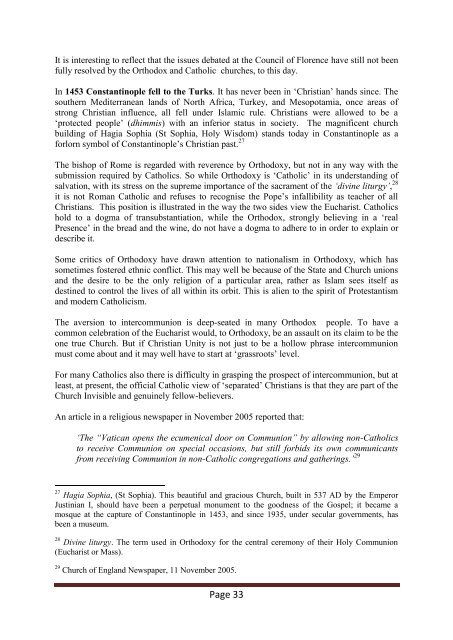Digging Out the Embedded Church - The Maranatha Community
Digging Out the Embedded Church - The Maranatha Community
Digging Out the Embedded Church - The Maranatha Community
You also want an ePaper? Increase the reach of your titles
YUMPU automatically turns print PDFs into web optimized ePapers that Google loves.
It is interesting to reflect that <strong>the</strong> issues debated at <strong>the</strong> Council of Florence have still not been<br />
fully resolved by <strong>the</strong> Orthodox and Catholic churches, to this day.<br />
In 1453 Constantinople fell to <strong>the</strong> Turks. It has never been in „Christian‟ hands since. <strong>The</strong><br />
sou<strong>the</strong>rn Mediterranean lands of North Africa, Turkey, and Mesopotamia, once areas of<br />
strong Christian influence, all fell under Islamic rule. Christians were allowed to be a<br />
„protected people‟ (dhimmis) with an inferior status in society. <strong>The</strong> magnificent church<br />
building of Hagia Sophia (St Sophia, Holy Wisdom) stands today in Constantinople as a<br />
forlorn symbol of Constantinople‟s Christian past. 27<br />
<strong>The</strong> bishop of Rome is regarded with reverence by Orthodoxy, but not in any way with <strong>the</strong><br />
submission required by Catholics. So while Orthodoxy is „Catholic‟ in its understanding of<br />
salvation, with its stress on <strong>the</strong> supreme importance of <strong>the</strong> sacrament of <strong>the</strong> „divine liturgy‟, 28<br />
it is not Roman Catholic and refuses to recognise <strong>the</strong> Pope‟s infallibility as teacher of all<br />
Christians. This position is illustrated in <strong>the</strong> way <strong>the</strong> two sides view <strong>the</strong> Eucharist. Catholics<br />
hold to a dogma of transubstantiation, while <strong>the</strong> Orthodox, strongly believing in a „real<br />
Presence‟ in <strong>the</strong> bread and <strong>the</strong> wine, do not have a dogma to adhere to in order to explain or<br />
describe it.<br />
Some critics of Orthodoxy have drawn attention to nationalism in Orthodoxy, which has<br />
sometimes fostered ethnic conflict. This may well be because of <strong>the</strong> State and <strong>Church</strong> unions<br />
and <strong>the</strong> desire to be <strong>the</strong> only religion of a particular area, ra<strong>the</strong>r as Islam sees itself as<br />
destined to control <strong>the</strong> lives of all within its orbit. This is alien to <strong>the</strong> spirit of Protestantism<br />
and modern Catholicism.<br />
<strong>The</strong> aversion to intercommunion is deep-seated in many Orthodox people. To have a<br />
common celebration of <strong>the</strong> Eucharist would, to Orthodoxy, be an assault on its claim to be <strong>the</strong><br />
one true <strong>Church</strong>. But if Christian Unity is not just to be a hollow phrase intercommunion<br />
must come about and it may well have to start at „grassroots‟ level.<br />
For many Catholics also <strong>the</strong>re is difficulty in grasping <strong>the</strong> prospect of intercommunion, but at<br />
least, at present, <strong>the</strong> official Catholic view of „separated‟ Christians is that <strong>the</strong>y are part of <strong>the</strong><br />
<strong>Church</strong> Invisible and genuinely fellow-believers.<br />
An article in a religious newspaper in November 2005 reported that:<br />
„<strong>The</strong> “Vatican opens <strong>the</strong> ecumenical door on Communion” by allowing non-Catholics<br />
to receive Communion on special occasions, but still forbids its own communicants<br />
from receiving Communion in non-Catholic congregations and ga<strong>the</strong>rings.‟ 29<br />
27 Hagia Sophia, (St Sophia). This beautiful and gracious <strong>Church</strong>, built in 537 AD by <strong>the</strong> Emperor<br />
Justinian I, should have been a perpetual monument to <strong>the</strong> goodness of <strong>the</strong> Gospel; it became a<br />
mosque at <strong>the</strong> capture of Constantinople in 1453, and since 1935, under secular governments, has<br />
been a museum.<br />
28 Divine liturgy. <strong>The</strong> term used in Orthodoxy for <strong>the</strong> central ceremony of <strong>the</strong>ir Holy Communion<br />
(Eucharist or Mass).<br />
29 <strong>Church</strong> of England Newspaper, 11 November 2005.<br />
Page 33








